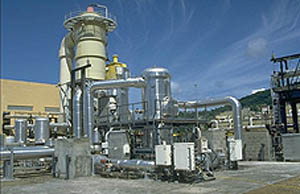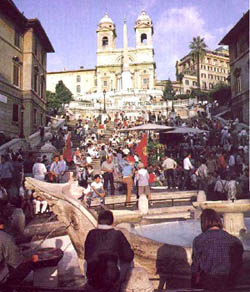






|

Solutions
The State of the Seas, The Heat Beneath our Feet, Volcano Produces Magma-watts, Urban Parks, the Cellphone Deluge, Subvert Suburbia & the New Urbanism.
June 22, 2002

The tranquility of the Florida Keys National Marine Sanctuary is threatened by climate change and pollution." Photo credit: NOAA. |
The State of the Seas
The worlds oceans - polluted, over-fished and rapidly warming - need all the help they can get. Some positive news comes with the announcement that the United Nations has launched a new website devoted to all things oceanic. On June 6, World Environment Day, the UN raised the curtain on is online atlas of the oceans. The website -- which offers "real-time links" to data on sea surface temperatures, global ice coverage, tsunamis and undersea volcanoes -- can be found at www.oceansatlas.org.
The Heat Beneath our Feet
Iceland leads the world in tapping geothermal resources. Today this ice-bound nation is pulling most of its heating needs from the seething superheated waters beneath its rocky soil.
At a depth of six miles below the Earths crust, the heat available in each square kilometer (.39 sq. mi.) of rock equals the heat produced by burning 15 million tons of oil (TOE, tons-of-oil-equivalent). This kind of heat is known as high enthalpy (high temperature) geothermal energy.
Now engineers in Europe are going to great lengths (not to mention great depths) to tap this free, inexhaustible geothermal heat. Geologists have discovered that the temperature of the rock two miles below the town of Soultz-sous-Forêts in eastern France approaches 392 F. Engineers estimate that drilling two bore holes -- one to pour water into the heated rock and another to direct the rising steam back to the surface -- could generate both heating and electric power for the city.

A steam-heated igloo in Iceland is kept comforatably warm with geothermal heat. |
The concept of such an artificial thermal reservoir (ATR) is being explored by a consortium of companies in France, Italy, Germany and England. Within three years, GEIE Heat Mining, a joint effort by Shell oil and three European energy giants, hopes to complete construction of an ATR capable of producing as much as 220 pounds of superheated (383 F) water per second.
If successful, this ATR prototype will generate 25 megawatts of electricity which, in turn, will be sold to Electricité de Strasbourg, a subsidiary of Frances utility giant EDF.
At depths of less than 3,000 feet, geothermal wells can still produce water heated to between 86 to 212 F. These so-called medium- and low-enthalpy resources could provide cheap heat and power for homes, farms and industry around the world. Geothermal wells do produce air pollution, however [details], and care must be taken to assure that unwanted emissions of gases and corrosive minerals are controlled.
A turn toward geothermal energy could reduce the production of greenhouse gases and help offset global warming. Some 35 geothermal power stations in the Île-de-France region near Paris and another 15 sites in the Aquitaine region of southwestern France are producing enough heat to replace the equivalent of 150,000 tons of oil. That translates into more than 700,000 tons of CO2 that were never released into the atmosphere.
According to the French Technology Press Office (FTPO), the installed power of these 50 geothermal plants is estimated at 400 MW, with potential growth estimated to be at least twice this capacity.
In La Courneuve, north of Paris, several public buildings, five public schools and 5,000 homes derive a significant portion of their heating needs from geothermal reserves that supply water heated to 135 F. La Courneuves Joint Association for Geothermal Energy will soon expand its services to another 1,000 homes. It is expected that the new, expanded service will eliminated the production of 4,400 tons of CO2.
A similar expansion of geothermal district heating is underway at Chevilly-la-Rue southeast of Paris where 1,600 new dwelling equivalents will be added to the 14,000 homes already supplied with free, clean heat from the Earth.
According to the FTPO, between 1995 and 2000, the amount of power produce by geothermal plants in Europe increased by 18%. The most rapidly growing form of geothermal technology, however, is the relatively inexpensive heatpump that draws heat directly from the soil relatively near the surface of the Earth. Eleven homes in Vaucresson, west of Paris, are extracting geothermal heat via a U-shaped pipe in a 230-foot-long bore hole. The savings on heating costs are expected to reach 65%.
Drawing heat from the bowels of the Earth is an option that is no longer reserved for a few rare sites with favorable geology, the FTPO notes.
For more information, contact: French Technology Press Office [1 East Wacker Drive, Suite 3740, Chicago, IL 60601 [www.ubifrance.com/]

The La Soufriere Volcano. |
Volcano Produces "Magma-watts"
To date, Frances most efficient geothermal plant isnt even located in France - It is to be found on Caribbean island of Guadeloupe in the French Antillies. The La Bouillante power station was built on the La Soufriére volcano. Subterranean water heated to a temperature of 320F is expelled upwards from a depth of 1,050 feet at a rate of 150 tons per hour. This raging tide of scalding vapor gives the powerplant an installed capacity of 5.3 Mwe.

Volcano-powered electricity on the flanks of Guadaluope's La Soufriere Volcano. |
With the construction of three additional bore holes, the Bouillante facilitys electric output is expected to triple, providing 10% of Guadaloupes electricity. Eventually, La Bouillante should be producing 25 Mw of electric power for the island nation. Several other Caribbean nations - including Dominica, Montserrat, St. Lucia and Grenada - are good candidates for volcanic electricity sites in the future.
Urban Parks
The Project for Public Spaces (PPS) is beating the drums for all the individuals, families and groups across the US that have taken it upon themselves to transform abandoned lots and crime-filled open spaces into parks and playgrounds. PPS not only applauds this movement that includes thousands of friends-of-parks groups, civic nonprofits, conservancies, activists, mayors and city park departments, it has now ventured into cyberspace with a website called Urban Parks Online [http://urbanparks.org] designed to help restore, improve and revitalize urban open spaces.
The website, managed by the nonprofit Urban Parks Institute, showcases great parks and public spaces from around the world and compiles lists of hands-on tools, databases of experts, success stories, and a national chat room where park and open-space activists can compare notes and share experiences.
 Europe's Plan to Divert the Cellphone Deluge Europe's Plan to Divert the Cellphone Deluge
This autumn, the European Parliament is expected to implement a Waste Electrical & Electronic Equipment Directive (WEEED) that will require the return and recycling of up to 80% of all electrical and electronic products. Currently most older cellphones are simply discarded and wind up in landfills.
XS Tronics [www.xstronics.com] plans to become one of the first companies to help WEEED out this pollution problem. EX Tronics is set to offer a comprehensive, large-scale mobile phone recycling program to the general public and manufacturers across Europe. In cooperation with European retail chains like Comet and Tesco, XS Tronics will encourage cellphone recycling through a number of incentives ranging from charitable donations and shopping discounts to reduced phone bills.
A May 2001 XS Tronix survey of cellphone users in the UK and Germany found that 85.58% would readily recycle their old phones if there were an easy and accessible recycling solution.
Old phones can be returned free to various XS Tronix Collection and Processing plants in pre-addressed, prepaid envelopes.
Plastics will be recovered and reused, precious metals like copper, silver, gold and palladium will be extracted and environmentally harmful metals like mercury, lithium, magnesium, nickel and cadmium will be isolated and reused.
Not all returned cellphones will need to be recycled. XS Tronics expects that fully "30% of all phones collected can be salvaged." After being repaired or refurbished, these older-but-still-serviceable models will be sent to developing countries in Asia, Africa, Eastern Europe & South America where they will provide an affordable alternative to the purchase of new cellphones.

The New Urbanism is a return to old paths of proven worth. Which path would you prefer to take -- gridlock on the highway or a cappuccino on the Steps of Rome. |
Subvert Suburbia
"New Urbanism" has been called "the most important planning movement this century." According to one resource-rich website devoted to this global movement [www.newurbanism.org], the goal is "to reform the design of the built environment [in order to raise] our quality of life and standard of living by creating better places to live." The New Urbanism website goes on to state:New Urbanism is the revival of our lost art of place-making, and is essentially a re-ordering of the built environment into the form of complete cities, towns, villages, and neighborhoods - the way communities have been built for centuries around the world. New Urbanism promotes the increased use of trains and light rail, instead of more highways and roads. New Urbanism involves fixing and infilling cities, as well as the creation of compact new towns and villages.
New Urbanism promotes the creation and restoration of diverse, walkable, compact, mixed-use communities [containing]... housing, work places, shops, entertainment, schools, parks and civic facilities, all within easy walking distance. The biggest obstacles are antiquated and restrictive municipal zoning codes. Adopting a system of modern "smart codes" can allow the transformation toward a New Urbanism without having to rewrite existing codes. Currently, there are more than 500 New Urbanist projects planned or under construction in the US alone, half of which are in historic urban centers.
The Principles of New Urbanism
The principles of New Urbanism can be applied increasingly to projects at the full range of scales from a single building to an entire community.
Walkability- Most things within a 10-minute walk of home and work
- Pedestrian friendly street design (buildings close to street; porches, windows & doors; tree-lined streets; on street parking; hidden parking lots; garages in rear lane; narrow, slow speed streets)
- Pedestrian streets free of cars in special cases
Connectivity- Interconnected street grid network disperses traffic & eases walking
- High quality pedestrian network and public realm makes walking pleasurable
Mixed-Use and Diversity- A mix of shops, offices, apartments, and homes on site. Mixed-use within neighborhoods, within blocks, and within buildings
- Diversity of people - of ages, classes, cultures, and races
Mixed Housing- A range of types, sizes and prices in closer proximity
Quality Architecture & Urban Design
Emphasis on beauty, aesthetics, human comfort, and creating a sense of place; Special placement of civic uses and sites within community. Human scale architecture & beautiful surroundings nourish the human spirit
Traditional Neighborhood Structure- Discernable center and edge
- Public space at center
- Importance of quality public realm; public open space designed as civic art
- Contains a range of uses and densities within 10-minute walk
- Transect planning: Highest densities at town center; progressively less dense towards the edge. This urban-to-rural transect hierarchy has appropriate building and street types for each area along the continuum.
Increased Density- More buildings, residences, shops, and services closer together for ease of walking, and to enable a more efficient use of services and resources
- New Urbanism design principles are applied at the full range of densities from small towns, to large cities
Smart Transportation- A network of high-quality trains connecting cities and towns together
- Pedestrian-friendly design that encourages a greater use of bicycles, rollerblades, scooters, and walking as daily transportation
Sustainability- Minimal environmental impact of development and its operations
- Eco-friendly technologies, respect for ecology and value of natural systems
- Less use of finite fuels
- More local production
- More walking, less driving
Quality of Life- Taken together these all add up to a high quality of life well worth living
Contacts and Resources
Books and Articles- Ecocities by Richard Register (Berkeley Hills Books, PO Box 9877, Berkeley, CA 94709)
- The Science of Smart Growth by Donald D. T. Chen (Scientific American, December 2000)
- How Cities Work: Suburban Sprawl and the Roads Not Taken by Alex Marshall (University of Texas Press, 2000)
- Suburban Nation: The Rise of Sprawl and the Decline of the American Dream by Andres Duany, Elizabeth Plater-Zsyberk and Jeff Speck (North Point Press, 2000)
- Once There Were Greenfields: How Urban Sprawl Is Undermining Americas Environment, Economy and Social Fabric by Kaid Benfield et al. (Natural Resources Defense Council, 1999).
- Great Streets by Allan B. Jacobs (MIT Press, 1999)
- The Celebration Chronicles: Life, Liberty and the Pursuit of Property Values in Disneys New Town by Andrew Ross (Ballantine Books, 1999)
- The Charter Book (Congress for the New Urbanism)
- The New Urbanism: Toward an Architecture of Community by Peter Katrz (McGraw-Hill, 1994)
- The Next American Metropolis by Peter Calthorpe [www.calthorpe.com] (Princeton Architectural Press, 1993)
- The Death and Life of Great American Cities by Jane Jacobs (Vintage/Random House, 1961)
For more information contact:
Contact the addresses and weblinks listed in the story.
|
|
|







